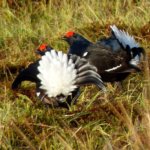 I had headed up to North Wales on Sunday afternoon for our early Monday-morning start to enjoy the wonders of a Black Grouse lek. I called in on the ‘Lake’ site for Hen Harriers that I mention in Inglorious (see Chapter 5) but there were few signs of spring in the mountains of Snowdonia. I hardly saw a Meadow Pipit and none was singing, nor any Skylark, and at the lake itself there were just a couple of honking Canada Geese and a pair of Great Black-backed Gulls. Not a Red Grouse called from the heather, not an Otter swam in the lake and not a Hen Harrier sky-danced the sky; but all of these things will be happening there soon as spring uncoils.
I had headed up to North Wales on Sunday afternoon for our early Monday-morning start to enjoy the wonders of a Black Grouse lek. I called in on the ‘Lake’ site for Hen Harriers that I mention in Inglorious (see Chapter 5) but there were few signs of spring in the mountains of Snowdonia. I hardly saw a Meadow Pipit and none was singing, nor any Skylark, and at the lake itself there were just a couple of honking Canada Geese and a pair of Great Black-backed Gulls. Not a Red Grouse called from the heather, not an Otter swam in the lake and not a Hen Harrier sky-danced the sky; but all of these things will be happening there soon as spring uncoils.
Another sign of spring is that as one drives up the A5 through sheep pastures occasionally one sees a pair of Herring Gulls, miles from the sea standing very close to each other. These are always adults, and always two birds, and always standing close together. They are very obviously pairs and very obviously not in breeding locations. They seem like couples who have slipped away from the crowds to enjoy some quality time on their own before settling down to bring up this year’s brood of young. I wish them well as I speed past on the straight parts of the road heading north.
It’s not all birding this trip, Ruth and I are planning a joint venture and so this was a planning trip (yeh right! – ed) but planning can be done in a restaurant drinking gin and tonic or red wine, in a car watching lekking Black Grouse, or in a cafe eating breakfast and watching some of North Wales’s only Yellowhammers on the feeder outside. Yes, it’s tough work but it needed to be done. More on our plans later this spring.
After the Black Grouse leks (for there were more than one) we did some general birding in the Welsh uplands in early spring. It was a ‘finches and raptors’ day with Chaffinch, Goldfinch, Bullfinch, Redpoll, Siskin and Crossbills (but no Linnets – result!) and Kestrel, Red Kite, Peregrines (quite a few), Buzzards, Merlin and a couple of Goshawks. And Alan saw a very distant Hen Harrier which the rest of us missed (although for a second I turned a distant Red Kite into a Hen Harrier – oh the shame!). Every time I go anywhere with the hope of seeing a Hen Harrier and don’t see one I always think to myself, ‘I bet Alan would have seen one’. Throw in some Dippers and Ravens, and an unexpected pair of Mandarin Ducks, and it was a good day’s birding. Better than good because the company was so good too.
Alan and Ruth (Ruth and Alan) make their living out of showing people birds – and they are very good at it (after all, Alan used to be a world record-holder and Ruth still is – see Behind the Binoculars). They were talking about their future overseas trips this spring to Arctic Scandinavia (I’ve always wanted to visit Verangerfjord), southern Spain (a favourite of mine), Extremadura (another favourite) and I felt a bit itchy to travel -although this is an itch that I rather rarely get. But it’s really striking every time I visit Alan and Ruth (Ruth and Alan) how many birds they’ve seen in the previous few days in North Wales. Now, there’s nothing wrong with North Wales and quite a lot right with it but I bet you don’t think of it as a birding hot-spot do you? Well, it depends on what you want – I haven’t seen Black Guillemot, Hawfinch or Chough in the last few days but Alan has. There’s great birding everywhere and although I have spent most of my birding life finding my own birds I’m increasingly happy to pay an expert to share their local expertise with me and take me to the right place at the right time and enjoy birds that I could find myself, but probably wouldn’t very easily.
[registration_form]
I wonder if the Welsh government have a figure for how much wildlife tourism is worth like the Scottish Government have? This increasing tourism is certainly putting the £s into many local pockets. Mull is well known for its £s and around 85% of the total economy but these figures need to be kept up to date as too often these incomes are increasing at an alarming rate especially as seasons tend to be increasing as they are on Mull. Tourists are coming off peak with cheaper accommodation and especially cheaper ferry prices. Need any information for Mull and trips to other islands – http://www.naturescotland.com/
Interestingly, since Mark mentions that southern Spain is a favourite of his, the local government in Cadiz Province seems increasingly aware of the value of bird tourism. They’ve even produced a handy little booklet on the topic (see – http://www.cadizturismo.com/media/publications/pdf/Birding_Cadiz_English.pdf). Anyone who’s not witnessed raptors en masse crossing the Straits is missing one of Europe’s greatest spectacles.